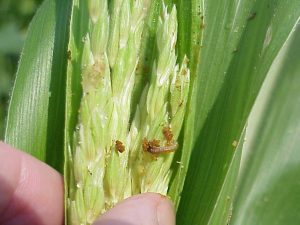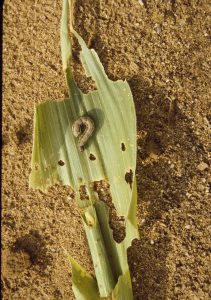Sweet Corn IPM Newsletter No. 3 — July 14, 2023
CORN EARWORM NUMBERS LOWER
Fall Armyworm Moths and Larvae Found in Several Fields
SITUATION
Early planted corn is now silking in much of southern Maine, while early-mid season corn is between whorl and pre-tassel. Many fields are showing signs of nitrogen and/or zinc deficiency, which is a result of the excessive rains leaching these nutrients out of the soil, while the heat encourages rapid plant growth. This makes it difficult for plant nutrient uptake to keep up with demand. There were fewer moths in traps this week, but silking corn is still at risk in most fields.

European corn borer: Larval feeding injury was found in over half of the sites visited this week. Fields in Wells and Biddeford were over the control threshold of 15% in pre-tassel stage corn. We have only caught one corn borer moth in our traps, but we expect to see more in the coming weeks, which may present a threat to any silking corn. Moths will lay eggs on flag leaves of silking corn, and the larvae can move into the ears without leaving visible feeding injury. Therefore, if more than five moths are caught in our traps during a week where there is silking corn, a spray will be recommended.
Corn earworm: The number of corn earworm caught this week was down from last week, but will still require protection in any silking corn for most locations. Fields not yet in silk do not need to be protected from corn earworm. We have seen some earworm feeding on whorl to pre-tassel plants, which will happen when silking corn is not yet available. This damage is counted, along with any borer or armyworm damage, to determine if a pre-silking spray is warranted. A 4-day spray interval for silking corn was recommended for one site in Wells. A 6-day spray interval was recommended for Auburn, Cape Elizabeth, Dayton, Farmington, Gray, Lewiston, and one site in Wells.

Fall armyworm: Moths were caught in pheromone traps at two sites, Auburn and Cape Elizabeth, this week, but not over threshold for silking corn. If more than 3 moths are caught in pheromone traps in a field with silking corn, a spray would be recommended. Some larval feeding damage has been found in pre-tassel corn. This is combined with any European corn borer injury found to determine if the 15% injury threshold has been reached. Sprays were recommended for fields in Wells and Biddeford, but only because injury from corn borer was also present.
Squash vine borer: We have been catching squash vine borers in pheromone traps around the state. Growers with squash should be on the lookout for vine borer symptoms and protect plants if moths or damage are seen. See the New England Vegetable Management Guide for control options.
Cucurbit downy mildew alert: With ongoing rainy weather there is now a high risk for cucurbit downy mildew throughout southern Maine and beyond. The strain being found primarily infects cucumber and cantaloupes. Producers of these crops should apply protectant fungicides prior to any future storms. These are listed in the New England Vegetable Management Guide . Chlorothalonil or copper products are protectant fungicides that most growers probably already have on-hand. It may be worth switching to fungicides with specific activity against CDM. They can also be found in the New England Vegetable Management Guide. Monitor your crops regularly, and keep an eye out for symptoms of CDM. Excellent photos and more information about this disease can be found on Cornell’s vegetable resources page.
Sincerely,
David T. Handley
Vegetable & Small Fruit Specialist
Highmoor Farm
P.O. Box 179
52 U.S. Route 202
Monmouth, ME 04259
207.933.2100
UMaine Extension Diagnostic
Research Lab, Pest Mgmt. Unit
17 Godfrey Drive
Orono, ME 04473
1.800.287.0279
| Location | CEW Moths | ECB Moths | FAW Moths | %Feeding Damage | Recommendations / Comments |
|---|---|---|---|---|---|
| Auburn | 3 | 0 | 2 | 8% | 6-day interval recommended for silking corn |
| Biddeford | 1 | 0 | 0 | 20% | One spray for ECB feeding on pre-tassel corn |
| Bowdoinham | 0 | 0 | 0 | 2% | No spray recommended |
| Cape Elizabeth | 2 | 1 | 2 | 6% | 6-day interval recommended for silking corn |
| Dayton | 3 | 0 | 0 | 0% | 6-day interval recommended for silking corn |
| Farmington | 6 | 0 | 0 | 3% | 6-day interval recommended for silking corn |
| Gray | 2 | 0 | 0 | 0% | 6-day interval recommended for silking corn |
| Lewiston | 2 | 0 | 0 | 0% | 6-day interval recommended for silking corn |
| Oxford | 1 | 0 | 0 | 0% | No spray recommended |
| Sabattus | 3 | 0 | 0 | 0% | 6-day interval recommended for silking corn |
| Wayne | 0 | 0 | 0 | 2% | No spray recommended |
| Wells I | 2 | 0 | 0 | 17% | 6-day interval recommended for silking corn |
| Wells II | 14 | 0 | 0 | 2% | 4-day spray interval for silking corn |
CEW: Corn earworm (Only fresh silking corn should be sprayed for this insect.)
ECB: European corn borer
FAW: Fall armyworm
| Moths caught per week | Moths caught per night | Spray Interval |
|---|---|---|
| 0.0 to 1.4 | 0.0 to 0.2 | No spray |
| 1.5 to 3.5 | 0.3 to 0.5 | Spray every 6 days |
| 3.6 to 7.0 | 0.6 to 1.0 | Spray every 5 days |
| 7.1 to 91 | 1.1 to 13.0 | Spray every 4 days |
| More than 91 | More than 13 | Spray every 3 days |
Thresholds apply only to corn with exposed fresh silk. Lengthen spray intervals by one day if maximum daily temperature is less than 80°F.
European Corn Borer Thresholds
Whorl stage: 30% or more of plants scouted show injury.
Pre-tassel-silk: 15% or more of plants scouted show injury.
Silk: 5 or more moths caught in pheromone traps in one week.
IPM Web Pages:
Explore Integrated Pest Management in Maine (UMaine)
Integrated Pest Management Data Visualization Tool (Penn State)
Integrated Pest Management (UMass Amherst)
Where brand names or company names are used, it is for the reader’s information. No endorsement is implied nor is any discrimination intended against other products with similar ingredients. Always consult product labels for rates, application instructions and safety precautions. Users of these products assume all associated risks.
The University of Maine is an equal opportunity/affirmative action institution.
